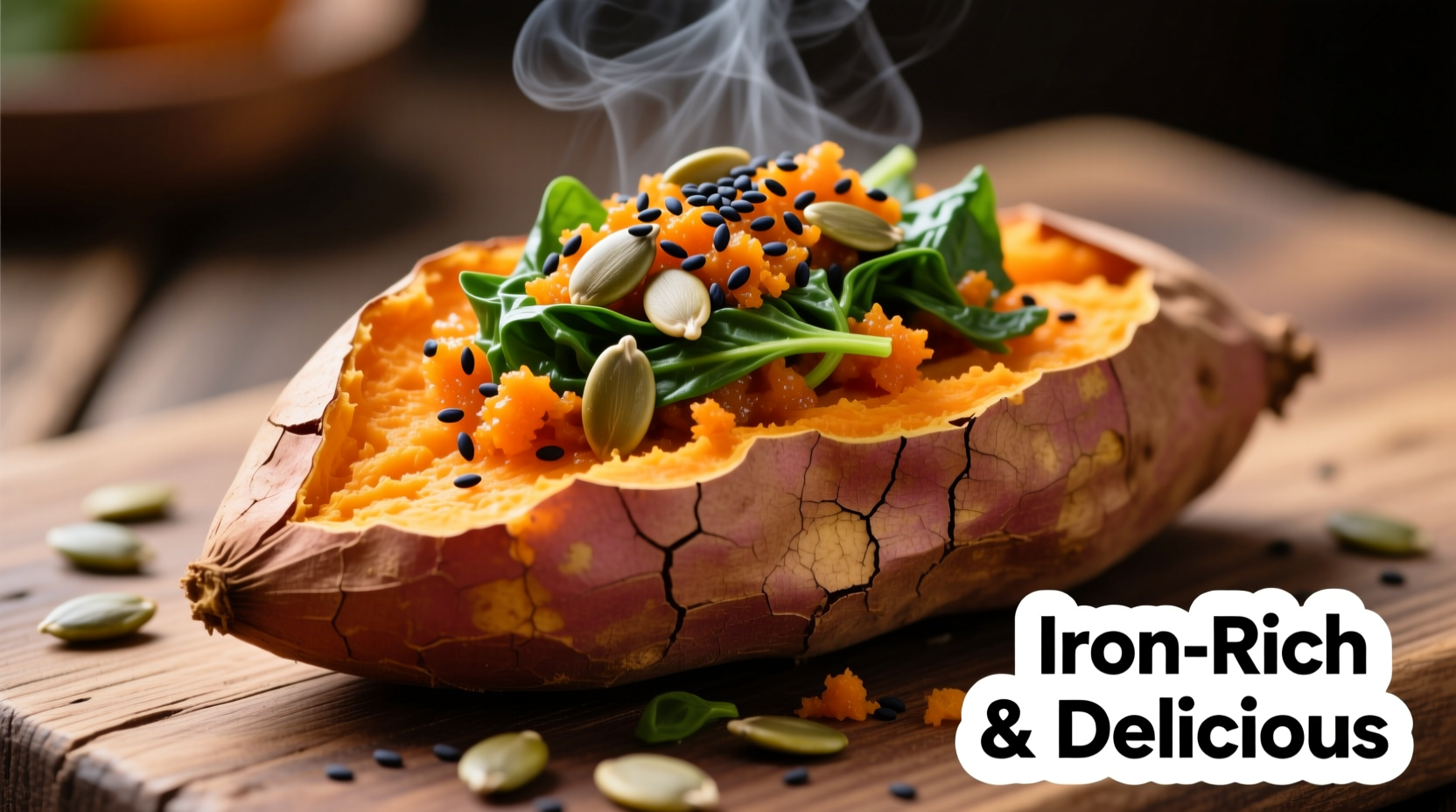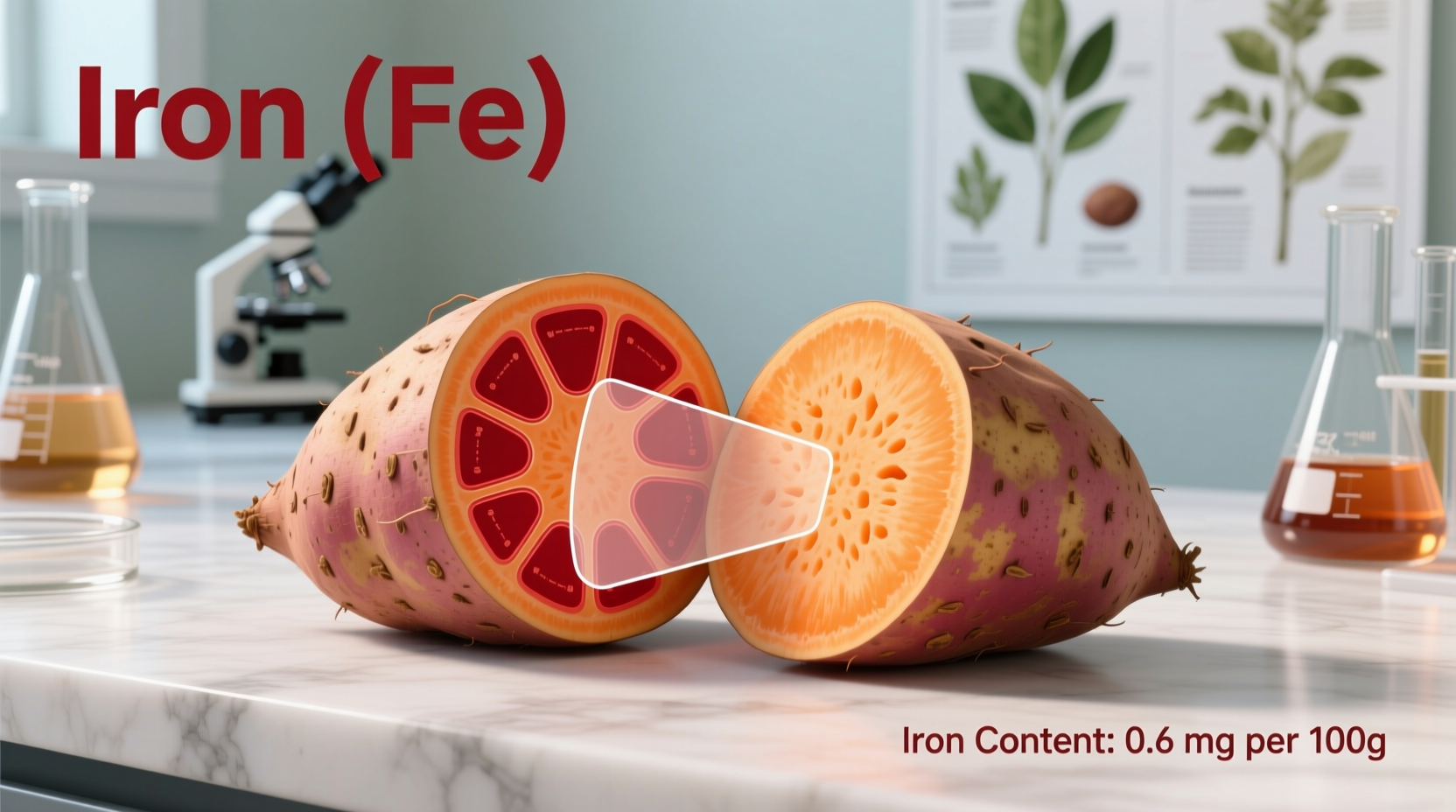Yes, sweet potatoes do contain iron—approximately 0.7 mg per medium-sized (130g) cooked sweet potato, which provides about 4-9% of your daily iron needs depending on age and gender. While not the highest iron source, they offer valuable non-heme iron alongside vitamin C that enhances absorption.
Understanding Iron Content in Sweet Potatoes: What the Data Reveals
When you're searching for plant-based iron sources, sweet potatoes deserve consideration. Let's examine the facts with precision. According to the USDA FoodData Central database, a medium cooked sweet potato (130g) contains 0.7 mg of iron. This represents approximately 4% of the daily value for adult men and 3.9% for postmenopausal women, while providing about 3.9% for premenopausal women who require significantly more iron.
| Food Source | Iron Content (per 100g) | Type of Iron | Percent Daily Value |
|---|---|---|---|
| Sweet potato (cooked) | 0.54 mg | Non-heme | 3% |
| Spinach (cooked) | 3.6 mg | Non-heme | 20% |
| Lentils (cooked) | 3.3 mg | Non-heme | 18% |
| Beef liver (cooked) | 6.5 mg | Heme | 36% |
Why Sweet Potato Iron Matters for Your Diet
Sweet potatoes contribute to your iron intake in ways that extend beyond simple numbers. Unlike animal-based heme iron (found in meat), sweet potatoes provide non-heme iron—the plant-based form that requires strategic consumption for optimal absorption. The real nutritional advantage emerges from sweet potatoes' natural vitamin C content (about 22mg per medium potato), which significantly enhances non-heme iron absorption when consumed together.
Research from the National Institutes of Health Office of Dietary Supplements confirms that vitamin C can increase non-heme iron absorption by up to sixfold when consumed simultaneously. This natural pairing makes sweet potatoes more valuable than their iron content alone might suggest.

Practical Iron Optimization Strategies
Maximizing the iron benefits from sweet potatoes requires understanding absorption dynamics. Here's what actually works:
- Pair with vitamin C-rich foods: Add bell peppers, tomatoes, or citrus to your sweet potato dishes to boost iron absorption by 2-6 times
- Avoid tea/coffee with meals: Tannins in these beverages can reduce iron absorption by up to 60% when consumed simultaneously
- Combine with other iron sources: Create balanced meals with lentils or chickpeas to increase total iron intake
- Cook in cast iron: Studies show this can increase iron content in acidic foods by up to 1600%
When Sweet Potatoes Fall Short for Iron Needs
While sweet potatoes contribute to your iron intake, they shouldn't be your primary source if you have increased iron requirements. Certain populations need more substantial iron sources:
- Pregnant women require 27mg daily—sweet potatoes alone can't meet this need
- Individuals with iron deficiency anemia need therapeutic doses best obtained from supplements or high-iron foods
- Vegans must carefully combine multiple plant iron sources throughout the day
The American Society of Hematology notes that plant-based iron has 2-20% absorption rates compared to 15-35% for animal-based sources. This doesn't make sweet potatoes irrelevant—it means understanding their role within a broader dietary strategy.
Sweet Potatoes in Your Nutritional Toolkit
Consider sweet potatoes as part of your iron strategy rather than your sole solution. Their true value emerges when combined with other iron-rich foods and absorption-enhancing techniques. For most healthy adults, incorporating sweet potatoes 2-3 times weekly contributes meaningfully to iron intake while providing additional benefits like beta-carotene, fiber, and potassium.
When planning meals for optimal iron nutrition, remember that dietary diversity creates the strongest foundation. Sweet potatoes offer a delicious, versatile component in this approach—particularly valuable for their natural vitamin C content that helps your body utilize the iron they provide.
Frequently Asked Questions
How much iron is in one sweet potato compared to regular potatoes?
A medium sweet potato (130g) contains approximately 0.7mg of iron, while a similar serving of white potato contains only about 0.4mg. Sweet potatoes provide nearly twice the iron content of regular potatoes, along with significantly more vitamin C which enhances iron absorption.
Does cooking method affect iron content in sweet potatoes?
Cooking method has minimal impact on iron content, as iron is a mineral that remains stable during cooking. However, boiling may cause slight leaching into water, while roasting concentrates nutrients. The most significant factor is what you pair with sweet potatoes—adding vitamin C-rich ingredients dramatically improves iron absorption regardless of cooking method.
Can sweet potatoes help with iron deficiency?
While sweet potatoes contribute to daily iron intake, they shouldn't be relied upon as a primary treatment for iron deficiency. A medium sweet potato provides only about 4-9% of daily iron needs. For diagnosed deficiency, medical professionals typically recommend iron supplements alongside high-iron foods like lentils, spinach, and fortified cereals. Sweet potatoes can complement these foods by providing vitamin C that enhances absorption of non-heme iron.
Are sweet potatoes a good iron source for vegetarians and vegans?
Yes, sweet potatoes are a valuable component of vegetarian and vegan iron strategies. While not the highest iron source, they provide non-heme iron alongside natural vitamin C that boosts absorption. For optimal results, vegetarians and vegans should combine sweet potatoes with other iron-rich plant foods like lentils, tofu, and spinach, while avoiding tea or coffee within an hour of meals to maximize absorption.











 浙公网安备
33010002000092号
浙公网安备
33010002000092号 浙B2-20120091-4
浙B2-20120091-4